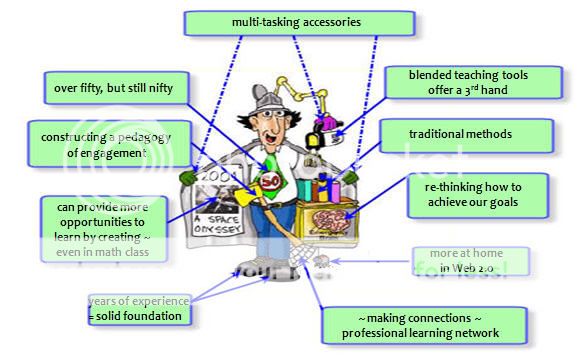As we each spoke, Steve sat at the front jotting ideas and themes down of a scrap of paper. He has a general shape of the day he builds in his CR2.0 wiki with the collaboration of the local contacts for each of these events. Before we took our first break he/we ammended that and then we plunged into a series of how to's and deeper discussions about teaching and learning in the 21st century. What emerged for me as the discussion progressed is the role that many in the room believe we has as a connective generation of teachers. We seem to feel we're the group that stands between the treasured values of the past ...


Steve's overall goal for the day was to mirror the Classroom 2.0 experience for the people in the room. I think our was to find a collection of like-minded educators here in BC and begin to share what we've learned and developed with people who are close by instead of far off in the US or other parts of the world.
I have to say I was amazed at the imaginative initiatives being undertaken in schools less than an hour or two from where I live:
- Brian whose Coquitlam school has decided to adopt an "open school" policy regarding students' use of personal devices for learning
- Jan whose classroom blog is like a hub for all her students' individual blogs and whose class blogroll is a collection of the blogs of other classes in Canada and the world to which her students respond
- Blair who has begun a Moodle to provide his grade 8 math students with access to resources 24/7
- Bryan who has started a master Delicious list (organised by subject) for his entire district (all teachers can forward their bookmarks to him and contribute to a district tag cloud that is available to them vie the district website)
- the district principle from outside the Lower Mainland who'd wanted to take back ideas to the teachers in his area and help them launch new projects.
- several experienced teachers old enough to be thinking about retirement, but who had postponed it because they are so excited by all the new things they were trying and they can't leave just yet!
I do know that it was a wonderful day. By the end of the day we had reaffirmed for ourselves that as a profession educators are moving away from being conveyors of information towards becoming community organisers and that we have tremendous power as leaders and role models to influence the deeper uses to which our students will put the tools they take to so naturally and information they can find so quickly. Web 2.0 is giving us a chance to claim a wonderful vocation for ourselves as teachers -- that of leaders, creators of educational experiences the students will remember even as adults, and the enlargers of minds.
As Jan said -- the power is in the connection, and it certainly was on Saturday in Room 3300.










 Wilkes University
Wilkes University



